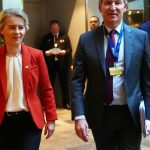Monsignor Gaid, former secretary of the Pope, is responsible for the place of worship inaugurated inside the “House of the Abrahamic Family”. Also open “to other Christian communities”, it wants to be a point of reference for the local community, largely made up of migrants. The “tireless” work of the pontiff in dialogue with Sunnis, Shiites and Jews and the fight against “the hemorrhage” of Christians in the Middle East.
Milan () – Tomorrow the first group of visitors is expected at the “House of the Abrahamic Family” in Abu Dhabi, United Arab Emirates (UAE), a complex founded on interreligious dialogue and made up of a church, a mosque and a synagogue. A center inaugurated on the weekend of February 17 to 19, in the presence of great personalities from the three great monotheistic religions involved in the project -Catholics, Muslims and Jews-, the first fruit of the historic visit of Pope Francis in February 2019 .
A place linked to the personal relationship built over the years between Pope Francis and Ahmad al-Tayyeb, imam of the Egyptian University of al-Azhar, a point of reference for Sunni Islam. Institutional personalities from the UAE were present at the inauguration, such as Saif bin Zayed Al Nahyan, Deputy Prime Minister and Minister of the Interior, and Nahyan bin Mubarak Al Nahyan, Minister of Tolerance and Coexistence. From the Vatican, the Pope sent Card. Michael Lewis Fitzgerald, Card. Miguel Ángel Ayuso Guixot, president of the Pontifical Council for Interreligious Dialogue, and Monsignor Yoannis Lahzi Gaid, who was his personal secretary, president of the Foundation for Human Fraternity and head of the Church of San Francisco in the House of Abraham.
“There would be no ‘House of the Abrahamic Family’ if there were no church, and it was Pope Francis who wanted to dedicate it to the poor little Assisi,” he explained to Monsignor Yoannis Lahzi Gaid, illustrating the value of the work. A name, he continued, linked to the saint “of which he himself bears the name” because Saint Francis “is the saint of universal brotherhood, peace, encounter, reconciliation and custody of creation.” And it is “on these values” that it has been built. He also recalled that the pontiff’s trip was intended “to commemorate the 800th anniversary of the meeting that took place in 1219 in Egypt between Saint Francis and Sultan Malik al-Kāmil.” “A meeting that, after eight centuries, never ceases to challenge, inspire and enlighten us in interreligious dialogue,” recalled Monsignor Gaid.
Inspired by human brotherhood
The Church of San Francisco, one of the three buildings, is the first tangible result of the journey that began with the document on the “Brotherhood” signed by the Pope and the imam. A Christian, a Muslim and a Jewish place of worship built next to each other, in a common space, but maintaining their own identity and respecting differences. All are equal in size and height and embody the common denominators of the three Abrahamic confessions, the work of architect David Adjaye: the mosque faces Mecca, the Church faces east while the Synagogue faces Jerusalem, with an inner garden connecting the three structures and reflects their symbolism. On the occasion of the inauguration ceremony of the church, the Pope sent a video message in which he recalled how faith should nurture “respect and peace”, never violence, adversity or war.
The al-Azhar imam, also in a video, recalled how the house is a faithful translation of the provisions of the document, which invites to guarantee tolerance and coexistence, religious freedom and the protection of places of worship. Finally, the chief rabbi of the United Hebrew Congregations of Great Britain and the Commonwealth, Ephraim Mirvis, present at the event, spoke of a “historic day” and a “historic building” because “it unites us in the love of God […] annulling the reasons for division”.
A “living” church
The Church of San Francisco, whose inauguration was attended by Monsignor Paolo Martinelli, Apostolic Vicar of South Arabia, and Bishop Emeritus Monsignor Paul Hinder, will not be “an empty symbol”, added Monsignor Gaid. On the contrary, he claims to be ‘infectious, alive and illuminating’. It will serve the Catholic community of Abu Dhabi for liturgical masses and prayers, but it will also welcome “other Christian communities” inside.
It wants to be, the Pope’s close associate warned, a “contagious” place due to its ability to attract “thousands and thousands of people to rediscover the beautiful figure of Saint Francis and follow in his footsteps.” A “living” place because it is a center “for dialogue, knowledge and mutual respect”. An “illuminating” symbol because “it turns on the light in a dark moment in history. “We only hear about pandemics, wars, earthquakes and economic and moral crises and we need to see a concrete project that speaks to us of coexistence and peace,” he warned .
As for the faithful, it will welcome pilgrims from all over the world, but it is designed above all for the faithful who live in Abu Dhabi or the Emirates. “It is very important”, recalls Monsignor Gaid, “to support the great Christian community made up of workers who live and work” in the Gulf, “some for a short time and others for a long time. Some of the faithful are second-generation children of parents who moved and settled. It must be remembered here that more than 200 different nationalities live in the Emirates and that it is a country where everyone can exercise their faith freely.” The House of Abraham is the firstborn, but there are other initiatives related to the document, as the pontiff’s secretary recalls: “The Higher Committee for Human Fraternity; the recognition by the UN of the day the document was signed, the February 4, World Fraternity Day, the Zayed Fraternity Award The creation of the Child Jesus Association in Cairo and the Human Brotherhood Foundation, which are overseeing the construction of an orphanage, a hospital and a school for the disabled. These are two organizations that work to transform the ‘fraternity concept’ into concrete works” to welcome, assist and help “brothers and sisters in need”.
A dialogue on the way
The document on the fraternity and the Church of San Francisco underlies the “tireless” work of dialogue promoted by Pope Francis, a “fundamental pillar”, as Monsignor Gaid defined it, of his pontificate. “An open, loyal and sincere dialogue”, he continued, “based on the truth” and based on the principles outlined in the speech of the University of al-Azhar: the duty of identity, the courage of otherness and the sincerity of intentions. “In this context – stressed the prelate – one can understand the interreligious dialogue with the Sunni Muslim world and the numerous trips” he made “to the Holy Land, Jordan, Turkey, Egypt, the United Arab Emirates, Morocco, Iraq and the most recent to Bahrain.
“All of this has produced numerous tangible fruits and will undoubtedly produce others that are even more important”. On the other hand, the Pontiff himself used to say that “the only alternative to the civility of the encounter is the incivility of the confrontation” and this is also true of the Shiite and Jewish worlds With the Shiite world, the relationship “is very good”, as can be seen from the trip to Iraq and the meeting with Ayatollah al-Sistani, and at the same time acts as a “bridge between Shiites and Sunnis”. the same is true of the Jewish world, “our older brothers, as Francis said in the Synagogue in Rome on January 17, 2016. ” Finally, Monsignor Gaid dedicated a final passage to anti-Christian persecution and to the diaspora from the countries of origin in the Middle East: “As an Egyptian – he concluded – I can affirm that the bleeding of Christians will never stop without the courage of those who open new paths and light lights”.
“EAST GATE” IS THE ASIANNEWS NEWSLETTER DEDICATED TO THE MIDDLE EAST
WOULD YOU LIKE TO RECEIVE IT EVERY TUESDAY IN YOUR EMAIL? SUBSCRIBE TO THE NEWSLETTER AT THIS LINK.





![[Img #74676]](https://thelatestnews.world/wp-content/uploads/2024/12/Laser-artificial-neuron-150x150.jpg)






